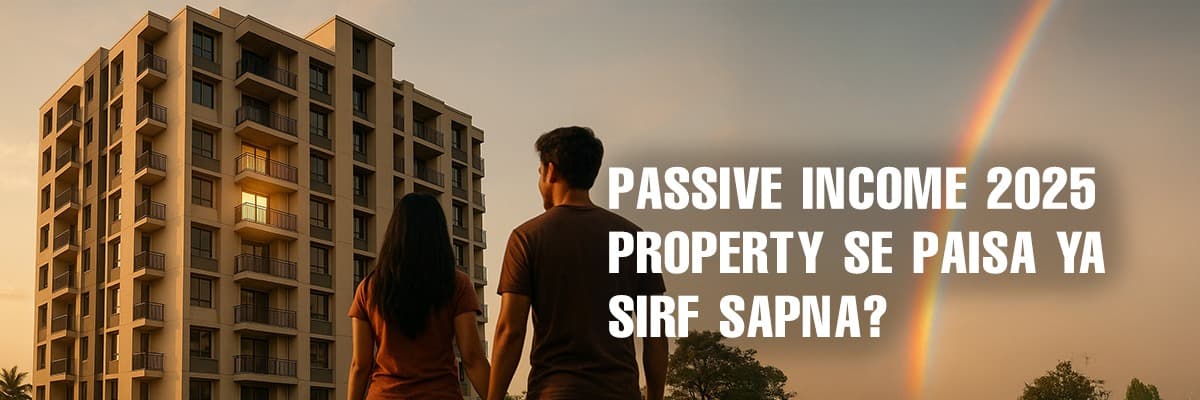Passive Income Through Real Estate in India: Building Financial Freedom and Emotional Security
Summary
Discover how real estate in India generates passive income, offering financial freedom and emotional security. Learn strategies for 2025 to build wealth and achieve long-term stability through property investments.

Passive Income Through Real Estate
For countless Indians, the idea of passive income isn’t just about wealth—it’s about freedom, hope, and the security to live life on their own terms. For a young couple like Aarav and Riya in Bengaluru, rental income from a single apartment means they can pursue dreams without being chained to a paycheck. For Shalini, a mother in Pune, income from her property ensures her children’s education is secure while giving her peace of mind. Real estate is more than investment—it’s a lifeline, a source of emotional and financial relief, and a stepping stone toward independence.
Why Passive Income Matters
Passive income allows people to breathe easier. It alleviates financial stress, creates stability, and gives room to dream bigger. It is the difference between living paycheck to paycheck and feeling secure, empowered, and hopeful.
For example, a small apartment in Jaipur generates rent that pays for living expenses, medical needs, and even small luxuries for a family. For young professionals in Tier-1 cities, rental income supplements salaries, enabling long-term goals like starting a business or traveling. The emotional impact is profound: security, freedom, and confidence in the future.
How Real Estate Generates Passive Income
Real estate provides consistent income streams through:
Residential Rentals – Apartments, villas, and flats in high-demand areas.
Commercial Properties – Offices or small shops that generate higher returns.
Co-Living and Serviced Apartments – Popular with young professionals, offering higher yields.
Strategic Pre-Launch Investments – Early booking in emerging neighborhoods provides rental opportunities when completed.
The key lies in choosing the right location, property type, and tenants, balancing rental yield and long-term capital appreciation.
Real-Life Stories
Consider Meera, a teacher in Jaipur, who invested in a modest apartment. The monthly rent covers her mortgage and provides a little extra to save for her children’s hobbies and education. The joy of seeing her property generate income is more than financial—it is freedom and pride.

Similarly, Sameer, an entrepreneur in Hyderabad, uses rental income to fund his startup ventures. Without it, risks would feel heavier; with it, he sleeps peacefully, knowing the property supports both ambition and security.
These stories show that real estate is more than bricks and money—it is hope, independence, and emotional stability.
Strategies for Passive Income in 2025
Focus on High-Demand Areas – Connectivity, schools, and employment hubs ensure tenants and steady income.
Diversify Property Types – Combining residential and commercial units balances yield and long-term appreciation.
Leverage Technology – Platforms simplify rent collection, tenant management, and maintenance.
Adopt a Long-Term Vision – Patience increases both financial returns and emotional peace of mind.
Consider Co-Living or Serviced Apartments – Especially effective in Tier-1 cities for consistent income.
The strategy is simple: balance financial logic with human understanding—knowing tenants’ needs and life patterns ensures stability and emotional relief.
Forecast for 2025
Experts predict growing rental demand in Tier-1 and Tier-2 cities, meaning:

Steady rental cash flows for property owners
Opportunities for first-time investors to build wealth and security
Expansion of co-living and serviced apartment options, meeting urban lifestyle needs
Passive income through real estate is not instant wealth—it’s a journey toward long-term stability, freedom, and peace of mind.
Emotional Perspective
Passive income changes lives. It provides families a sense of security, allows young adults to embrace independence, and gives entrepreneurs the confidence to pursue ambitions. Every rental payment is not just money—it is freedom, relief, and a step closer to life goals.
In 2025, those who invest wisely in property are not just building wealth—they are creating emotional safety nets, securing futures, and opening doors to dreams once thought unreachable.
Final Thoughts
Real estate is a powerful tool for generating passive income in India. With careful planning, smart investments, and patience, families and individuals can enjoy financial security, emotional relief, and the freedom to make life choices without stress. In 2025, passive income through property is not just about money—it is about hope, stability, and turning dreams into reality. For many, it is the bridge between aspirations and tangible life achievements, combining financial growth with deeply human fulfillment.
Summary (100 words)
Passive income through real estate in India is far more than a financial strategy—it is a source of hope, freedom, and emotional security. Monthly rental income allows families to cover expenses, pursue dreams, and plan confidently for the future. For young professionals, it supplements salaries and reduces financial stress, while for entrepreneurs, it funds ventures without fear. Real-life examples show how rental income brings pride, independence, and peace of mind. In 2025, real estate is a pathway to both financial growth and deeply human fulfillment, empowering individuals to live with security, confidence, and freedom.
